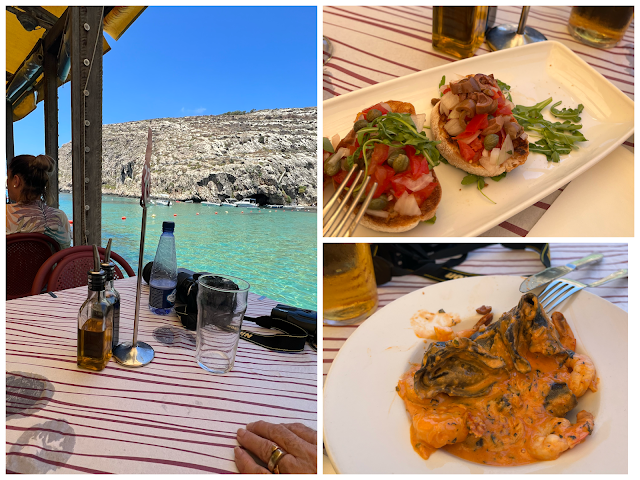Today we drove to the northern part of Malta past the Victoria Lines which are fortifications. We didn’t actually see the fortifications but this was originally known as the North West Front and is a line of fortifications that spans 12 km along the width of Malta, dividing the north of the island from the more heavily populated south. They were built in the late C19th by the British to deter invasion from the north. We were heading for the second biggest island of the archipelago of Malta, Gozo Island also known as Homer’s legendary Island of Calypso. In Greek mythology, Calypso was a nymph who lived on the island of Ogygia (Gozo me thinks), where, according to Homer's Odyssey, she detained Odysseus for 7 years. [Now, as I write this, I am in Athens and surrounded by Greek mythology. Untangling it from actual history is often very difficult].
I thought that perhaps I'd include a map of where the archipelago of Malta is and where this small island is that we are heading to today. Gozo is one of the three largest islands in the 7-island archipelago of Malta. Malta is such a tiny island nation yet has attracted many invaders, would-be conquerors.
 |
| Malta with neighbouring Sicily as a size comparison |
 |
| Gozo is the small island to the NW of the main island |
Anyway there we were across the North West Frontier on a ferry bound for Mgarr Harbour. There we were bundled into a bus - as a small diversion we are back driving on the left side of the road, very confusing - and driven through winding streets at rather a breakneck pace out into the countryside where we visited Ta' Pinu Church. This church was built by public subscription following a miracle in 1883 involving a spinster, Karmni Grima, and a small chapel located on the site. That original chapel has been incorporated into the larger church. Outside the church are great sweeping walls covered in mosaics and inside the church all the images are mosaics not paintings and they really glow.
 |
| Ta' Oinu Church - imposing in the distance |
 |
| The walls of mosaics in front of the church are most impressive |
 |
| Stunning detail |
 |
| These are all mosaics |
Time to head back for a look around Victoria which is known for its medieval Citadel, with fortified walls. There's only so much walking one can do so we opted for a cool drink in the square rather than to walk to the citadel - or shop as many people did.
 |
| The decorated pillars intrigued me |
Apparently Gozo is famous for its crystal clear swimming beaches and harbours. With swimming in mind, we were taken to a pretty little harbour village of Xlendi in the southwest of the island. A few went in for a swim while most of us sat right on the very edge of the water in the shade – it was delightful. The restaurant, Churchill, has quite a history. Anthony Grech excavated the rock in 1947 (auspicious year!) to make a boathouse for small fishing craft and later turned it into a bar. It is named Churchill because he had great admiration for Winston Churchill. It was a delightful place and evidently they serve sizzling steaks on lava stones. We had Tortellacci which was black pasta stuffed with seafood and cream and infused with Pernod plus some Bruschetta. Delicious!
 |
| The land looks ddry and rocky |
 |
| I was quite taken with the balconies |
 |
| Extremely narrow roads just waiting for a jam |
On the way back we got caught in a bad traffic jam. The roads are so narrow and we were in a large bus - say no more. Eventually we got moving but Gilberto had to get out and 'direct' traffic at one stage.
 |
| I found the language quite intriguing. |
I found the language quite intriguing. It is a conglomeration of many languages reflecting the occupying nations over the millennia - it is made up of 60% Semitic (Arabic) and you can hear that clearly in the spoken language, 30% Roman/Latin and it incorporates words from other languages even creating new words as hybrids. Although most closely related to Arabic, the letters are written in Latin English which is the last adopted language - the Btritish were the last occupiers. What lies ahead for this feisty little island nation situated at the crossroads of many powerful nations is anyone's guess but it has a long and proud history.


























No comments:
Post a Comment